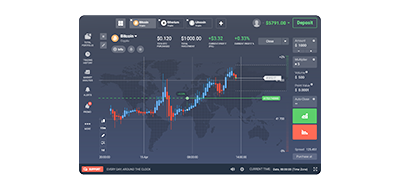กลับ
Contents
What is the Ichimoku Cloud?

Iva Kalatozishvili
Business Development Manager

Demetris Makrides
Senior Business Development Manager
The Ichimoku Cloud is a technical analysis tool that traders can employ to gain insight into the potential path of market movements, the zones of support and resistance, and momentum. Coming from Japan, this technical analysis indicator aggregates variables into a single chart to provide a general picture of market trends. By symbolizing market equilibrium with its applicability throughout several markets and periods, traders utilize the Ichimoku Cloud to guide their trading decisions.
Elements of the Ichimoku Cloud
The Ichimoku Cloud consists of five elements that collectively provide an overview of market trends, momentum and possible support and resistance levels.
To begin with, the Conversion Line (Tenkan sen) is calculated by averaging the high and lowest low over the nine periods. This line plays a role in identifying short term trends. It can act as an early signal for potential trend changes. It offers traders insights into the momentum by reflecting recent price movements in the market.
Moving on to the Base Line (Kijun sen), it offers a different viewpoint by averaging highs and lows over the past 26 periods. This line holds significance as it not only indicates medium term trends but often functions as a support or resistance level. Traders can gauge the market trend based on how the Kijun sen moves, whether it suggests a downward or sideways trend.
The Leading Span A (Senkou Span A), which represents an average of Tenkan sen and Kijun sen is plotted 26 periods ahead of the price.
This forecast marks one side of the cloud and assists in estimating levels of support or resistance. It offers a looking viewpoint that enables traders to predict where significant price barriers may arise.
Adding to this is the Leading Span B (Senkou Span B) calculated by averaging the high and lowest low over the 52 periods and similarly projected 26 periods ahead. The space between Senkou Span A and Senkou Span B is shaded to form the “Kumo,” or cloud. This cloud serves as a zone for support and resistance with its thickness indicating the strength of these levels. A thicker cloud suggests support or resistance while a thinner cloud signifies weaker levels.
Lastly, the Lagging Span (Chikou Span) represents the closing price. Plotted 26 periods behind the most recent price movement. This lagging signal enables traders to compare price levels with past data, aiding in confirming the strength and direction of trends. By illustrating how current prices align with market movements the Chikou Span can validate signals from elements of the Ichimoku Cloud.
The combination of these factors offers traders an in-depth perspective of the market, making the Ichimoku Cloud a valuable tool for those seeking insights into price movements.
How the Ichimoku Cloud Works
Ichimoku Cloud involves integrating these elements to present a view of market conditions. The prominent feature is the cloud itself created by Senkou Span A and Senkou Span B, offering a depiction of support and resistance levels. When the price is above the cloud, it shows a trend. The cloud serves as a support level. Conversely if the price falls below the cloud it indicates a trend with the cloud acting as a barrier, or resistance.
The thickness of the cloud is also important. A thicker cloud implies stronger support or resistance, making it more challenging for prices to move through. On the other hand, a thinner cloud suggests weaker levels. Because of the adjustments that occur over time, traders are able to anticipate regions of support and resistance, which enables them to more efficiently plan their trade entrances and exits.
Ichimoku Cloud Application
Traders utilize the Ichimoku Cloud for a range of purposes, including trend identification, likely reversal determination, and trading entrance and exit point determination.
Traders may quickly determine the market’s direction by analyzing the price’s location relative to the cloud. If the price is below the cloud, it suggests a downward tendency; if it is above the cloud, it suggests an upward trend.
For the market, the cloud functions as a dynamic zone of support or resistance. Once the price moves into the cloud, consolidation or a slowing down in speed might occur. A trend breaking above or below the cloud might mean either that it will continue or that it will reverse.
Intersecting the Tenkan-sen and Kijun-sen lines produces buying and selling signals. One may utilize these indications for selling or buying. For example, if the price is higher than the cloud and the Tenkan-sen crosses the Kijun-sen, this might be a strong signal that it is time for a purchase. Conversely, a crossing under the cloud might suggest a possible opportunity to sell the asset.
Advantages of Using the Ichimoku Cloud
Traders often prefer using the Ichimoku Cloud due to its advantages, especially its ability to offer a comprehensive view of the market. One of its strengths lies in its analysis capabilities. Unlike indicators that focus on just one aspect of market behavior, the Ichimoku Cloud combines trend identification, momentum evaluation and support/resistance levels all in one chart. This allows traders to have an understanding of market dynamics without needing indicators that could clutter their analysis.
Another significant advantage is how visually clear and easy to understand the cloud structure is. The unique appearance of the cloud makes it simple to interpret market conditions quickly at a glance, helping traders promptly determine whether the market is trending or consolidating. Moreover with its color coded format identifying support and resistance zones, it becomes intuitive, enabling traders to make better informed decisions.
The Ichimoku Cloud’s versatility stands out as another factor. It is an excellent instrument for a variety of trading strategies, as it is compatible with a wide range of markets and timeframes, including Forex, commodities, and equities. Whether traders specialize in short-term investing, day trading, or both, the Ichimoku Cloud has proven to be a valuable market instrument. By projecting support and resistance levels, this cloud assists traders in anticipating price movements before they happen. This predictive element gives traders an edge over technical indicators that rely mainly on historical data. With the Ichimoku Cloud traders can get insights into market trends enabling strategic trade planning.
Shortcomings of the Ichimoku Cloud
Although the Ichimoku Cloud is a versatile tool, it is not without its restrictions. In order to take on informed trades, traders who rely on this indication must be aware of these limitations.
The Ichimoku Cloud can be complicated, which is a major obstacle when utilizing it for some. The indicator includes lines and a shaded region commonly known as the cloud, which might pose a challenge for beginners to interpret.
The latency of the Ichimoku Cloud may result in the loss of opportunities in volatile markets, where prices fluctuate frequently. It is possible for traders to find that a considerable amount of price movement has already occurred by the time a signal is verified.
In scenarios where market direction is unclear, the indicator may produce false signals, potentially resulting in losses. The cloud structure, which performs well in trending markets, may not offer support or resistance levels in markets where prices move within a narrow range.
Moreover the standard settings of the Ichimoku Cloud (9, 26 52) were initially designed for the stock market in Japan, which used to operate on a six day trading week. In today’s markets, where a five day trading week’s the standard practice, these settings may not always be ideal. The fact that traders often have to adjust the settings to fit different markets and periods adds another level of complexity to how it is used.
In addition, not all assets or trading techniques will work with the Ichimoku Cloud, despite its flexibility and applicability across markets. For example, the reliability of the signals provided by the cloud may be diminished in markets with little liquidity or high volatility due to the cloud’s impaired prediction precision. Traders that are more concerned with high frequency or short-term trading may find the indication too complex or slow for their needs.
Common Errors When Utilizing the Ichimoku Cloud
Despite its effectiveness, traders often make mistakes in interpreting signals from the Ichimoku Cloud, leading to wrong trading choices. One prevalent mistake is fixating on components of the cloud rather than considering its overall framework. For example some traders may overly rely on Tenkan sen and Kijun sen crossovers without taking into account the context provided by the cloud itself or the Chikou Span. This oversight can result in trading positions being taken without a grasp of prevailing market conditions.
Another frequent error is disregarding the thickness of the cloud. Traders who overlook this aspect might enter trades prematurely, unaware that significant resistance or support levels could impede price movement before aligning with their expectations.
Traders also sometimes make the mistake of applying default settings for the Ichimoku Cloud across all markets and timeframes.
The default settings were created to suit a specific market environment. It may not be ideal for all trading situations. Failing to adjust these settings to match varying market conditions or time frames can result in signals and unfavorable trading choices.
Moreover, solely relying on the Ichimoku Cloud without verifying signals with other indicators or analysis methods is another common error. While the Ichimoku Cloud is thorough, it performs better when used alongside tools like volume indicators or fundamental analysis. This approach helps prevent signals and offers a well rounded perspective of the market.
Customizing the Ichimoku Cloud
By itself, the Ichimoku Cloud is a very powerful indicator. However, it can be even more potent when properly adjusted to fit specific markets and timeframes. As mentioned earlier, the original application for this indicator was the Japanese stock market that operates on a six day trading week. As a result, it needs to be adjusted to the current trading conditions of the market.
When using the cloud in a Forex market, traders often adjust the settings to shorter periods, such as 7, 22, and 44 (not financial advice). Changing to this setting allows the signals to better reflect the 24/5 nature of the FX market. When using the Ichimoku Cloud to trade commodities or equities, adjustments must also be made. These markets often react to external forces and influences, such as supply and demand, weather events, or geopolitical tensions. To ensure reliable signals, the Cloud settings must be adjusted and fine-tuned to identify and capture the current market trends.
The Ichimoku Cloud can also be adjusted across different timeframes, depending on the trading specifics. For example, a day trader or scalper and a swing trader will need to adjust the time frames accordingly.
Short term traders, such as day traders or scalpers, typically use the 5 and 15 minute charts for the Ichimoku Cloud to capture trends, see market momentum, and identify entry and exit points. In the shorter time frames, the cloud is able to respond and adjust quicker to the price swings.
Traders that prefer to trade the longer time frames, such as swing traders or investors, typically use the daily and weekly charts with the Cloud. Since they are not bothered by the short-term volatility of the asset, the bigger time frames smooth out the and get rid of the short-term noise, and highlight the significant trends, as well as the major support and resistance levels that play the all-important roles in long-term trading.
Conclusion
The Ichimoku Cloud serves as a versatile tool that gives traders a view of the market. By consolidating elements into one indicator it paints a detailed picture of trends, momentum and support/resistance levels. Whether used for trend identification, reversal spotting or trade planning, incorporating the Ichimoku Cloud into your trading arsenal is crucial. Mastering this indicator can greatly boost your ability to navigate markets confidently and accurately.
อัปเดต:
19 ธันวาคม 2567

